Throughout the world the generation that grew up in the 1990s found in manga, anime, and their game spinoffs a mesmerizing universe. On the one hand, they saw young protagonists achieving justice where their elders had been unable to do so, in dynamic environments ranging from sci-fi planetscapes to verdant, mythical never-pasts of our own world. On the other, violence and suffering were central tenants of the genre, heightening the torments that adolescence can bring upon us. This variety can be a foil for politically charged themes such as sexuality, freedom, history, and gender issues, with built-in cultural references and associations that provide rich ground for exploration. Contemporary artists have certainly noticed, and in the right hands, this can be as liberating as it is challenging. The result is a genre of great diversity. Three major artists drawing from its codes – Cajsa von Zeipel, Ai Yamaguchi, and Makoto Aida – give a sense of its breadth, complexity, and substance.
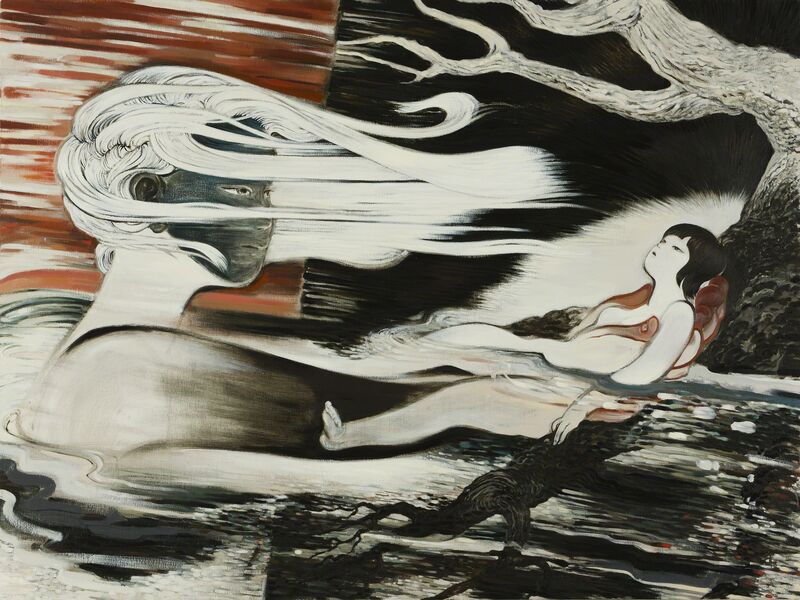
The ‘Superflat’ exhibition organized by Takashi Murakami at the Museum of Contemporary Art in Los Angeles in 2001 boosted these idioms to high-status signifiers. After decades of exhibitions, academic writing, and global cultural diffusion, it shouldn’t be surprising that some of the most forward-looking explorations of manga and anime-related creative vocabularies are by non-Japanese artists.
The recent work of Swedish artist Cajsa von Zeipel illustrates just how far things have evolved. Von Zeipel’s polychrome silicone figures are bodies in transformation – mutant and mutable in their queerness. Mommy Crane (2022) depicts a purple-haired woman, nearly nude but for some shredded denim, writhing under the burden of four infants in tattoo-designed bodysuits who cling to her as they seek her milk. Her swollen breasts are fitted with pump attachments and tubes, and containers of milk sprout from her fingers and head. Even her buttocks have nipples. She has been reduced to a nightmarish milk machine, but she seems to be holding on. In the partner piece Gay Milk (2022), an assertive, pregnant woman eyes us suspiciously, her unborn child swimming in milky fluid, visible through the disturbingly translucent flesh of her baby bump. Another infant is strapped to her thigh like a weapon, and her breasts are imprisoned in a bulky high-tech milk-pumping harness. Both works suggest sadistic medical experiments which center on lactation as an extractive industry – a frank and unflinching statement of how female identity continues to be bound to motherhood.
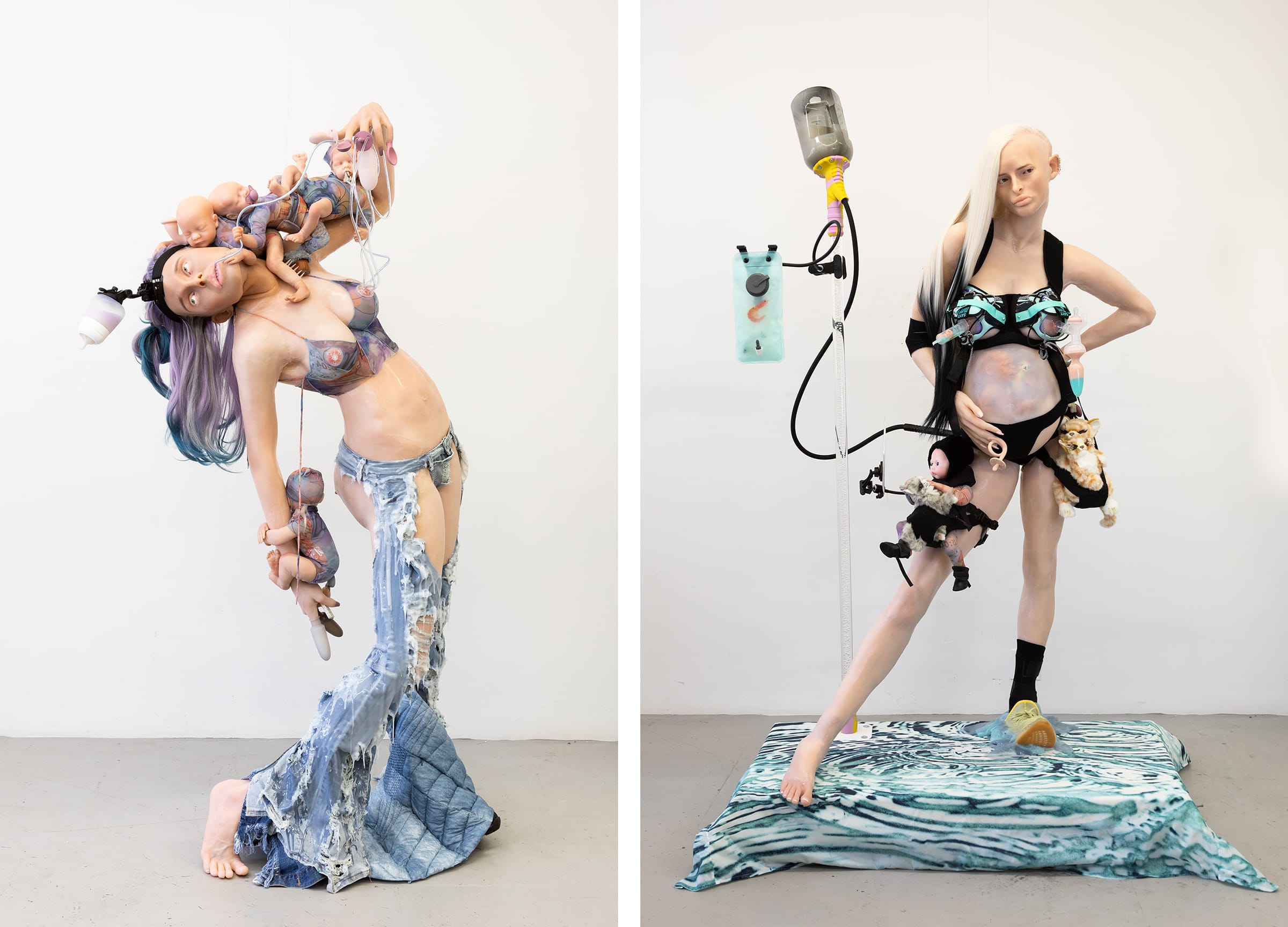
Both Mommy Crane and Gay Milk hark back to the tradition of Madonnas, particularly the motif of ‘Madonna lactans,’ in which a stream of milk often sprays from the Virgin Mary’s exposed breast as a symbol of fertility, nurturing, and protection. But von Zeipel’s large body of related work is also distinctly sci-fi in mood and vocabulary. In its disturbing depiction of biological bodies merged with machines, it recalls the ever-transforming, machine-possessed cybermutants in Katsuhiro Otomo’s outstanding manga series Akira (1982–1990), which was made into a groundbreaking film in 1988.
Von Zeipel might deflect these anime and sci-fi associations in favor of more personal narratives. But with anime having become a major conduit of global fantasy over the decades since Akira ignited a biomachine explosion, the cultural DNA of anime, sci-fi, and art which investigates similar future-oriented themes has become so closely entwined that these readings are difficult to escape.
Images of lactation and the emission of bodily fluids often feature prominently in hentai (literally ‘perverted’) manga, a popular subgenre characterized by sexually explicit imagery and storylines, including many considered aberrant. Over the past decades, this has also been the case in some manga-derived contemporary art. Gay Milk is a particularly illuminating counterpoint to Takashi Murakami’s Hiropon (1997). This large figure is a nude anime/manga-style young girl with brightly colored hair, squeezing a massive stream of milk from the phallic nipples of her preposterously large breasts. The milk forms a ring in the air around her body, like a skipping rope. It’s a hentai fantasy trope of the type popular with obsessive but socially awkward Japanese manga and anime fans known as otaku, and is derived from a familiar stock of interchangeable, sexually acquiescent female characters aimed at adolescent Japanese boys.
Hentai can be distinctly oedipal in tone, with males finding sexual comfort in being mothered and acting on their incestuous urges. Murakami notably insisted that his work was not intended as a criticism of this idiom. Rather, that he simply found it an interesting phenomenon. Hiropon was an editioned work, like its companion piece, My Lonesome Cowboy (1998), in which a spiky-haired young nude male, reminiscent of Goku from the popular Dragon Ball Z series, ejaculates copiously, spraying like a fire hose. When first shown, these were considered transgressive artworks, and even after 25 years they remain alarming and powerful. However, they represent a decidedly male vision unconcerned with the deeper consequences of such caricatural depictions of sexuality. Von Zeipel’s equally graphic approach anchors its shock value in current discourses about the bodily agency of women.
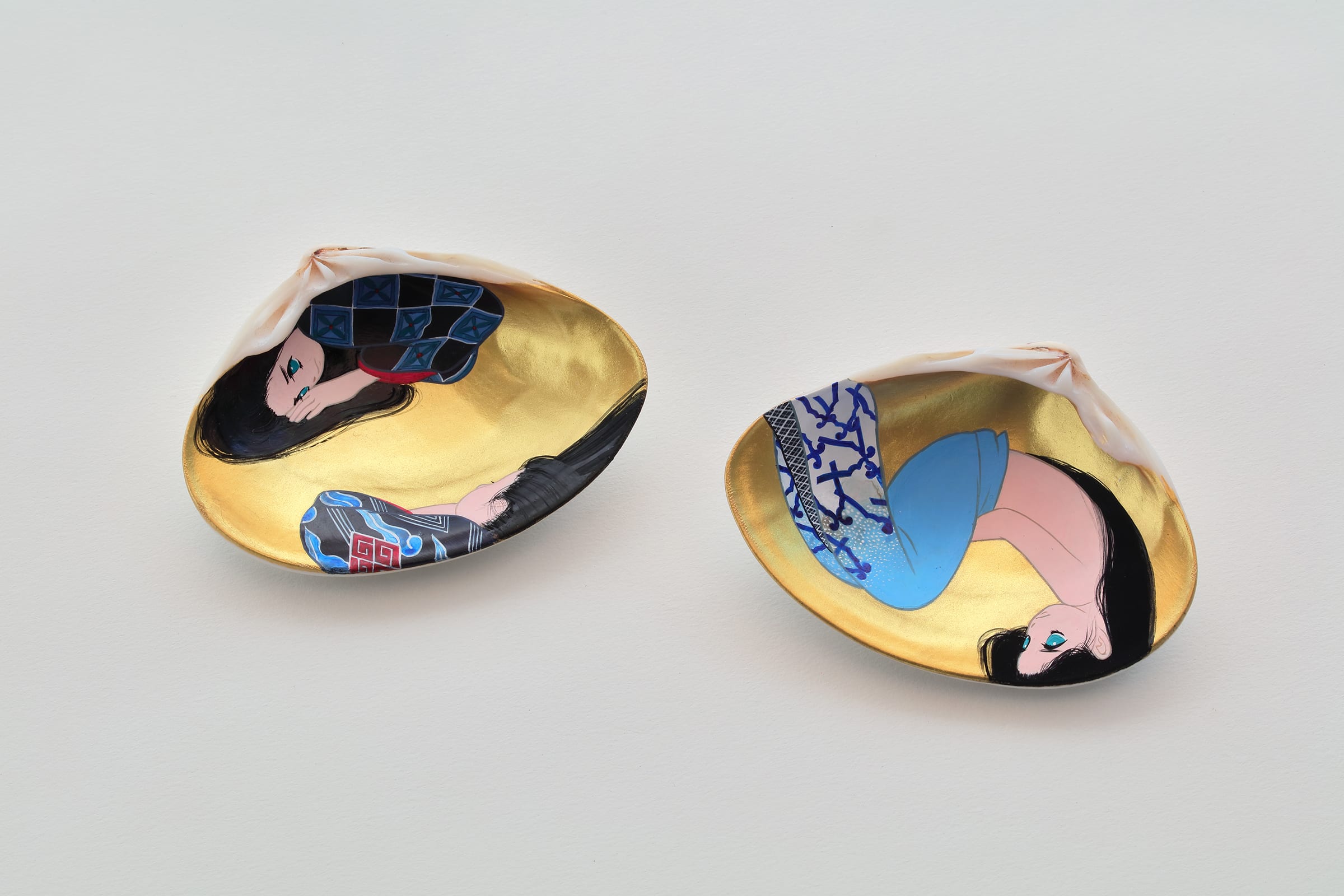
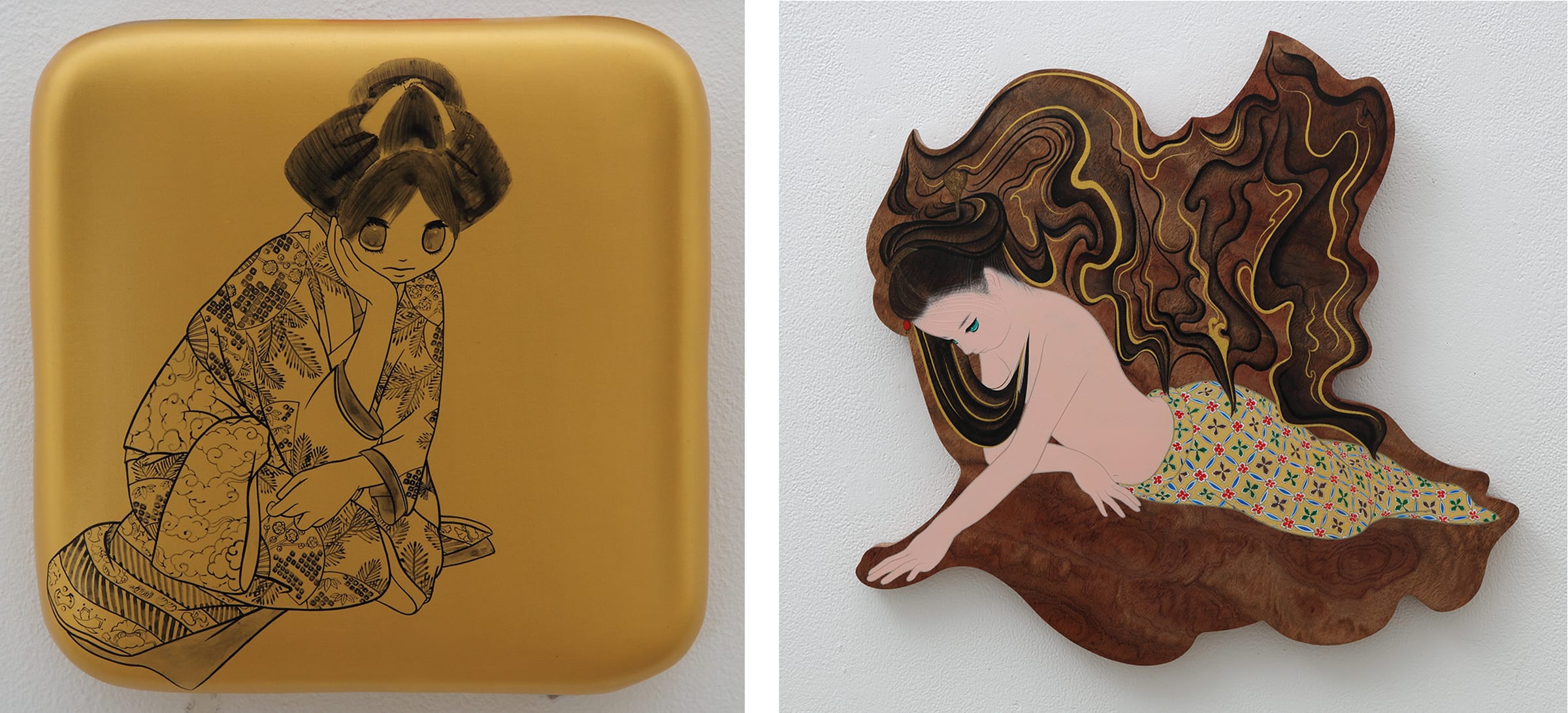
In contrast, Ai Yamaguchi deals with the experience of sexual trauma suggestively. She employs traditional Japanese decorative motifs such as fans and shells, and her work displays a linear flatness and compositional style overtly derived from traditional Japanese ukiyo-e woodblock prints (and possibly also from Murakami, at whose studio she worked for a time). Yamaguchi’s practice sheds light on a somber chapter of Japan’s history, when, during the Edo period (1603–1867), many young girls were sold into prostitution by their relatives in need of money.
In Yamaguchi’s works, often painted on bedding materials that have been shaped over wooden panels and are intimate in scale, the women are posed in their off-time, contemplating their fates. Even when nude, however, the figures’ bodies are only represented by simple outlines devoid of sexual characteristics. As is often the case in manga, however, their passive and expressionless saucer-eyed faces convey numbness and resignation. Yamaguchi’s body of work is an ongoing narrative, with a set of fixed characters who also appear in sumi ink on washi paper and on porcelain ceramics, and occasionally in large-scale installations. Taken as a whole, the oeuvre suggests that the girls will eventually come to dominate the men they are forced to serve. This occurred regularly in the yūkaku sex districts of Japan at the time: In addition to enjoying higher status and greater deference than their male customers, popular geisha could become wealthy enough to start their own businesses.
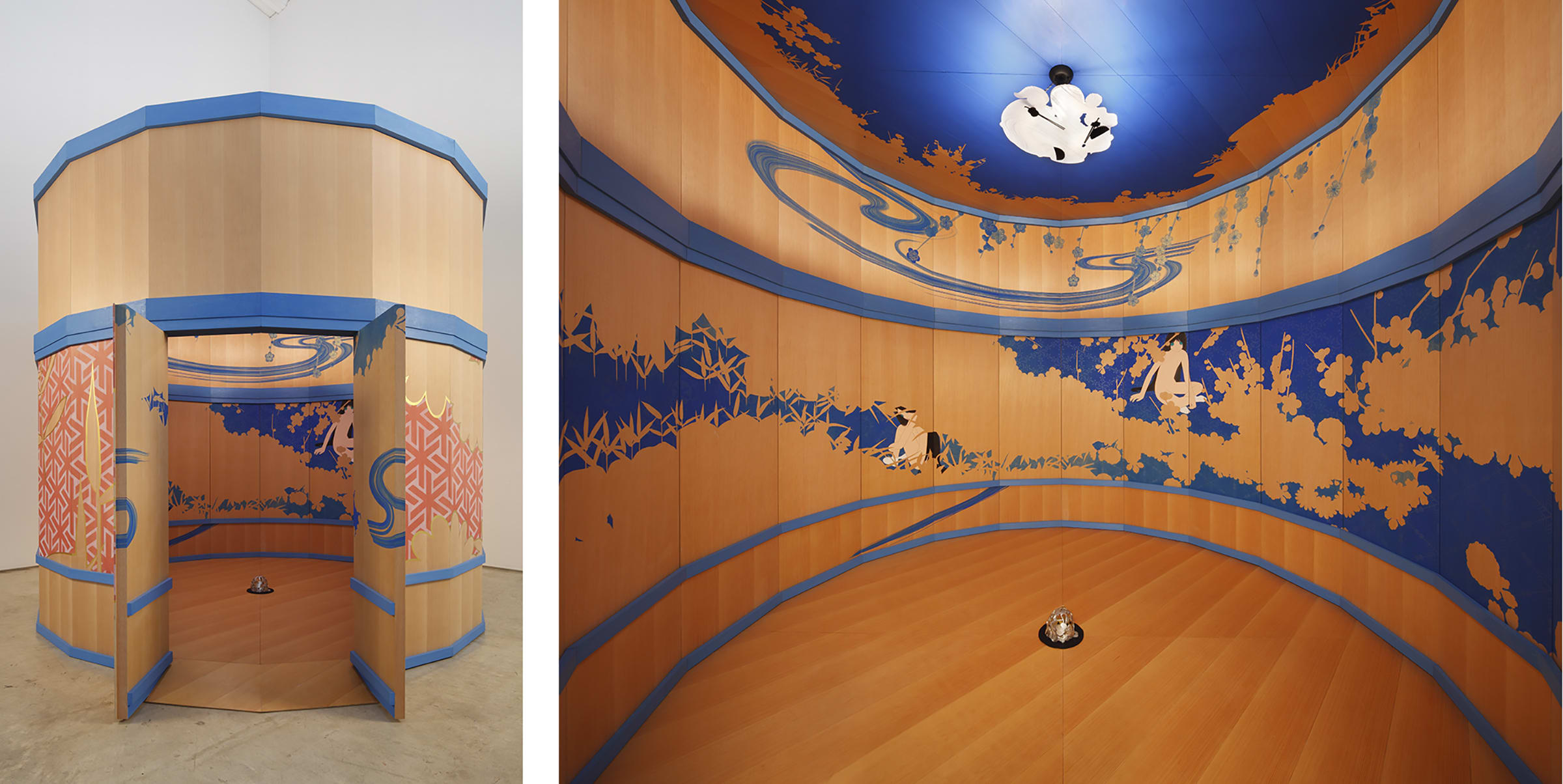
Sexuality is often merged with themes of social justice in both manga and anime; this is also the case in contemporary artworks that draw on them, and antiauthoritarianism is woven into their DNA. Makoto Aida, who rose to fame in the 1990s for his often-disturbing depictions of sexual violence (a reflection on the pathological aspects of Japanese sexuality, according to the artist), has become a well-established touchstone for pop-tinged socially-engaged contemporary art in Japan. He is one of the few Japanese visual artists in the post-1980s period to look explicitly at the theme of war, Japanese militarism, and its ongoing consequences. Much of his work draws equally on manga and historical Japanese art.

A primary example is his famous 1996 painting, A Picture of an Air Raid on New York City (War Painting Returns). Adopting the historically resonant format of a six-panel byōbu folding screen, it depicts a squadron of Second World War-era Japanese Zero-Sen fighter planes tracing a Möbius-strip formation over a burning Manhattan. The fighters shimmer blue and pink against the red and gold of the city below, seen from a traditional Japanese aerial perspective. Although the work refers directly to the wartime genre of heroic propaganda paintings known as senso-ga, the draftsmanship in the work is pure manga. There is only mock heroism here, and in line with the staunch antiauthoritarianism evident in much of Aida’s other work, which has opened him up to attack by Japanese nationalists in the past, he pushes viewers to question political fantasies of victory.
Let’s Start from the Developing Countries (2018), a satirical painting that reimagines characters from the popular anime series Neon Genesis Evangelion, is another example of Aida’s sensibility to political and social topics. In it, youthful figures disrobe amidst a jumble of postapocalyptic debris rendered in ashen hues, the title boldly emblazoned above them like a political slogan. The work satirizes the typical tone of Japanese domestic political messaging, which seeks to downplay catastrophic vulnerabilities, highlighting instead desirable potential outcomes, whether from Fukushima, COVID-19, or World War III. In this portrayal, global apocalypse supposedly presents the opportunity for a simpler and freer life, devoid of material goods. Back to nature it is.

There are quite a few artists around the world working today in what can be considered an ‘evolved’ manga and anime-influenced style. Junko Mizuno deals amusingly with the feminine condition, and Okokume (Laura Mas Hernandez) has gained a following for her high-chroma paintings of the character Cosmic Girl. The work of the groundbreaking collective, No Ghost Just A Shell (1999), coordinated by the French artists Pierre Huyghe and Phillippe Parreno, is long overdue a reexamination. And we still have a lot to learn from octogenarian Keiichi Tanaami, whose career extends almost as far back as manga itself. The three artists discussed at length here, however, are emblematic of the deeper social and political dimensions of manga/anime-derived contemporary art, and its capacity for carrying ever-weightier content.
Cajsa von Zeipel is represented by Company Gallery (New York) and Andréhn-Schiptjenko (Stockholm and Paris).
Ai Yamaguchi and Makoto Aida are represented by Mizuma Art Gallery (Tokyo, New York, and Singapore).
Azby Brown is a leading authority on Japanese art, architecture, and design, and has lived in Japan since 1985.
Published on January 23, 2023 by Art Basel.


Leave a Reply